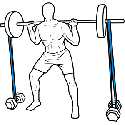5 Simple Steps to the Human Flag
We like to break down complex movements, explain the principles behind them, what we need to do and then how we can progressively build up the specific strength aspects we need for things like the Human Flag.
The Human Flag is certainly one of those movements that feel impossible when you first try it. But stick with us and we’ll show you how to redefine your impossible!
Principles of the Human Flag
First, we need to understand the movement and what we are dealing with. The Human Flag can be broken down into three component forces. The top arm is pulling, the bottom arm is pushing and these opposing forces create torque that leverages the body upwards. Whether you’re able to hold your torso and legs out straight after you’ve leveraged yourself up comes down to the oblique strength to pull your hips up towards your top pulling arm.
It’s key to remember that the forces involved are very high if you’re to be successful. The pulling and pushing forces need to be very large but also equal in order to maintain stationary. It’s also a huge challenge mentally or neutrally for the brain to produce these three forces simultaneously, as well as the fact that we never push and pull maximally with opposing arms. So it’s a skill we need to learn in creating the correct movement pattern as well as developing the specific strength required.
Can You Create The Shape?
The shape of the human flag is an overhead position, it’s just that you’re on your side horizontally. The arms need to create an equal triangle in an overhead position. This creates the stable base from which you can apply the pushing and pulling forces to generate that torque.
It’s important that you have the shoulder mobility to create this overhead position as without it you are fighting a losing battle, as the forces you will be applying will be in the wrong direction. The first exercise (overhead band rotation – step 1) in the video will help you test your overhead mobility but can also be used as a warm-up exercise and one to improve that shoulder mobility.
Can You Single Arm Hang and More…?
As previously mentioned the top arm in your Human Flag is the pulling arm. A great exercise for working this straight arm pulling motion is the single arm active hang (see the video for a demonstration – step 2). Once you can pull with that single arm the second aspect of the pull on the top side of your body is the oblique strength to pull the hip up towards the shoulder of that top pulling arm (see step 3).
Once you have the single arm active hang and oblique pull working nicely together we can then add the opposing push from the bottom arm. However, because this is a complex movement we can give the brain a fighting chance of piecing it all together if we work in a more controlled or easier environment or set up. The angle flag (see step 4) provides exactly that. Because we aren’t working directly against gravity, due to the angle of the body, the forces required are significantly less. Yet it allows the body and brain (neuromuscular system) to learn the correct movement pattern and muscle activation we need to develop.
Finally, in step 5 we take it to the full flag but allow for some additional help from the resistance band just to bridge the difficult gap in a progression from the angle flag to the full horizontal Human Flag. You can progressively reduce the tension and size of the band until your comfortable with the Human Flag with no assistance at all!
Just because it’s hard that doesn’t mean it’s impossible, work with us to redefine your impossible! Don't forget to check out our selection of calisthenics equipment and portable resistance band calisthenics kits in the shop if you are burning for deep gains.
If you liked this content and it helps you redefine your impossible of the Human Flag we’d love to hear from you. The School of Calisthenics has a graduates page on their website.
Thanks for reading. Class dismissed!
*This article was written in conjunction with one of our partners: David Jackson of the School of Calistheinics in Nottingham UK.



